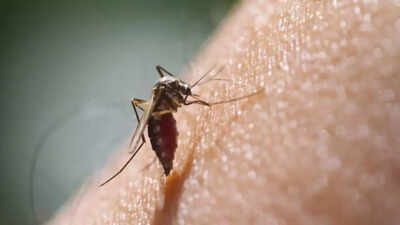ARTICLE AD BOX

A major outbreak of the chikungunya virus in southern China has alarmed health authorities globally. Mostly concentrated in Foshan city, Guangdong Province, over 7,000 people have been infected since mid‑June this year.
The US Centers for Disease Control and Prevention (CDC) has issued a Level 2 travel alert, advising travelers to practice enhanced mosquito precautions and consider vaccination where available. While fatalities remain rare, the illness brings severe fever, joint pain, fatigue, and sometimes long‑lasting aches that affect daily life.
Chikungunya outbreak in China: What’s happening
China is currently battling one of its most significant chikungunya outbreaks in decades.
Most cases, more than 7,000, are centered in Foshan, Guangdong Province, with smaller clusters in nearby cities like Guangzhou, Shenzhen, Dongguan, and Zhongshan. Although reported fatalities are few, health officials emphasize the strain on local healthcare systems. Infected individuals are being quarantined in mosquito‑proof hospital wards for about a week, and authorities have deployed aggressive mosquito control measures, including drones, larvae‑eating fish, and even predatory non‑biting "elephant mosquitoes," to suppress Aedes populations.
The CDC’s Level 2 travel advisory calls for enhanced precautions for travelers to Guangdong, emphasizing that while chikungunya is rarely deadly, its symptoms (mainly fever and joint pain) can be disabling, especially for older adults and infants.
Which countries are at risk
According to the CDC’s current travel health notices, the following are the key risk areas:Outbreak zones: Guangdong Province, China, including Foshan.Additional outbreaks: Kenya, Madagascar, Mauritius, Mayotte, Réunion, Somalia, Sri Lanka, and Bolivia’s Santa Cruz department, all flagged by the CDC for active outbreaks.Countries at elevated risk even without a current outbreak include India, Pakistan, Brazil, Colombia, Mexico, Nigeria, the Philippines, and Thailand, due to frequent travel-associated cases in recent years.The CDC recommends vaccination for travelers heading to outbreak zones, if eligible, and urges pregnant women and older adults to discuss risks with their healthcare provider.
What is the Chikungunya Virus?
Chikungunya is caused by a virus transmitted to humans through the bite of infected Aedes mosquitoes, mainly Aedes aegypti and Aedes albopictus.
These mosquitoes bite mostly during the daytime and are also known to carry viruses like dengue and Zika.The word "chikungunya" comes from the Makonde language of East Africa and means "to become contorted," referring to the bent posture of patients suffering from joint pain due to the disease.

How does Chikungunya spread?
The virus spreads when a mosquito bites an infected person and then bites someone else. It does not spread directly from person to person.
After a bite from an infected mosquito, symptoms typically appear within 4-8 days but can range from 2-12 days. The illness usually lasts about a week, but joint pain can persist for weeks or even months, especially in older adults.International travel can also help the virus travel. A single infected traveler in a mosquito-prone area can lead to a local outbreak.
Recognizing and managing symptoms
Typical symptoms appear in a week after being bitten by an infected mosquito and usually include:Sudden high feverSevere joint pain, especially in wrists, ankles, knees, and fingersMuscle aches, headache, rash, fatigue, and joint swellingMost people recover within a week, but joint pain can linger for weeks, months, or even years, especially in older individuals or those with pre‑existing joint conditions.Since there is no specific cure for chikungunya, the treatment focuses on relieving symptoms and helping the body recover.Some home care tips that can help:Rest: Your body needs energy to fight the virus.Stay hydrated: Drink water, juices, and clear soups to avoid dehydration.Pain relief: Use paracetamol (acetaminophen) to reduce fever and joint pain. Avoid aspirin or ibuprofen until dengue is ruled out, as they can cause bleeding.Cold compresses: Applying cold packs on swollen joints can ease pain.Nutrition: Eat light, nourishing meals to regain strength.Physical therapy or rehabilitation: Useful if joint pain and stiffness persist.Medical attention: If symptoms worsen, last beyond two weeks, or include bleeding, breathing trouble, or confusion, you’re advised to consult a professional healthcare provider. Infants, elderly people, and those with chronic conditions are at higher risk of complications and need prompt care.

Prevention tips: How to stay safe
Since there is no vaccine yet, prevention is the best protection. Here’s how to lower your risk:Avoid mosquito bites: Use insect repellent (DEET, picaridin, or oil of lemon eucalyptus). Wear long-sleeved shirts and pants. Sleep under mosquito nets, especially during the day if you're resting. Use window and door screens to keep mosquitoes out.Eliminate breeding grounds: Empty, clean, or cover containers that hold water (flowerpots, buckets, tyres).
Change water in birdbaths and pet bowls regularly. Keep drains unclogged and gutters clean.Travel smart: Before traveling, check the CDC advisories for any chikungunya outbreaks in your destination. Discuss vaccination options (e.g., Ixchiq for adults 18+, Vimkunya for age 12+ in the US) with your healthcare provider. Note the vaccine pause in older adults beyond a certain age due to safety concerns. Furthermore, pack insect repellent and netting in your travel bag. Stay in air-conditioned or well-screened accommodation.
Pregnant travelers, especially near delivery, should reconsider visits to outbreak zones as transmission to newborns is possible.



.png)
.png)
.png)
















 17 hours ago
3
17 hours ago
3








 English (US) ·
English (US) ·